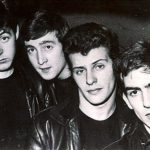Kelly Kathleen Ferguson helped us think about the “second best” (figure skaters, runners, but especially drummers) in her essay of that title in Issue 14.1. We loved reliving our memories of the music mentioned in her piece and are glad to share with you a companion playlist to accompany her essay (read an excerpt here):
Kelly Kathleen Ferguson: In my essay “Second Best,” I grapple with my time as a drummer in a rock band, and how drummers Pete Best (the Beatles) and Chad Channing (Nirvana) haunted me, since they were fired and replaced right before their former bands skyrocketed to fame.
For this post, let’s take an even closer look at the difference between anecdote and legend. Be forewarned—as a drummer, I enjoy the intricacies of music measurement and use insider lingo.
First, let’s look at Pete Best. He was a longtime band member and drew a legion of screaming fans.
What happened? One theory is that he didn’t fit in—while the rest of the gang was “nutty and noisome,” Best was too moody, too broody. Then there were rumors that the future Sir Paul was jealous of Best’s looks. Best wasn’t quirky, British good-looking, he was good-looking, good-looking.
Were personal problems the reason, then? If you’d asked Best’s mother, the answer would have been yes. Then again, check out this recording of Best playing live:
Best was known for his “Mersey Beat,” meaning his pounding kick drum, hence the Beatles. Except while the caveman thud worked in the club, in the studio Best’s 1-2-3-4 got old. It’s hard to hear bass in old recordings, but it’s easy to pick up on how he sounds repetitive. By contrast, think about the peppy seamlessness of Ringo Starr. I don’t even have to post a music clip. We all know it.
On to Chad Channing, the next-to-last drummer of Nirvana. Here’s a recording of Channing playing “In Bloom”:
Back in the day, Channing would have ruled Liverpool. He’s a solid player with musicality. In my essay I mention how Grohl admits that he kept most of Channing’s parts. Note the signature introductory fills and the pulsating cymbal during the verse.
Now listen to Grohl:
Grohl demands attention with the same intro. Then there’s how he blisters through a thirty-second–note fill leading into the chorus, versus Channing’s weaker roll.
If you were listening super closely, then you also noticed how, in the verse, Grohl plays sixteenth notes on the bass (that double sound on the one), instead of Channing’s single note. This simple yet critical change fills in the space, creates more drive.
So—have we figured out the difference between a good and bad drummer? I found this clip below of professional drummer Brandon Khoo trying to explain at a clinic. The audience boos when he brings up Meg White (of The White Stripes) and Ringo Starr (who has suffered his own criticisms over the years). You can see Khoo doesn’t agree, and for the record I don’t either. For while people love to analyze chops, the truth is that it’s not all about being the best drummer, but about being the right drummer in the right place, with the right mojo. If anyone has figured out how to measure that, let me know.











